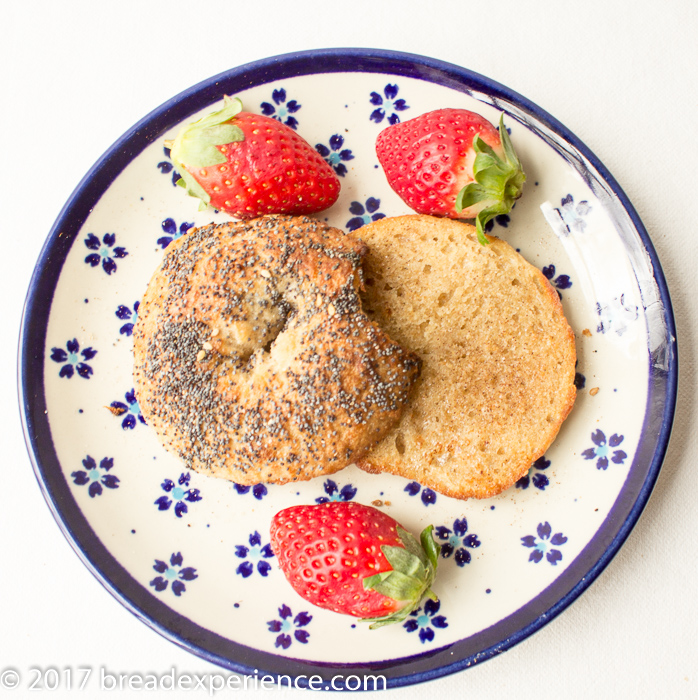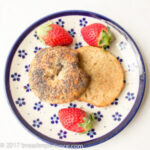These Sourdough Kefir Milk Bagels utilize sourdough and kefir milk as the fermentation agents and include sprouted wheat flour for good measure.

Recently, as I was developing a new kefir milk culture, I found myself with an abundance of kefir milk. To use up some of the extra milk, I decided to make bagels similar to the Kefir Milk Pumpkin Bagels I made a while ago.
For this experiment, the kefir milk wasn’t completely cultured yet so to ensure the bagels rose properly, my apple starter served as the raising agent and the kefir milk provided extra fermentation and enrichment. The bagels also included a mix of all-purpose flour and sprouted red fife flour for added flavor and nutrition. This combination seemed to work rather nicely. With all of the added enrichments, the whole grain flour didn’t weigh the bagels down.
I enjoyed the texture and flavor of these bagels. They are chewy as bagels should be, but not overly so, and they have good keeping quality due to the inclusion of sourdough and kefir milk. They lasted a week on my counter, stored in a plastic bread bag.
As with all bagels, these taste best fresh from the oven; however, they will last for several days. Just reheat them in the oven or toaster and serve with cream cheese or your choice of spread. For a delightful alternative, I enjoyed them toasted, spread with butter, and sprinkled with cinnamon sugar.

It was fun making these bagels using sourdough and kefir milk. They are easy to prepare and taste great which got me thinking about how they would compare to bagels made with other types of ferments. I decided to experiment and find out.
Bagels made with different types of ferments
- Gluten-Free Bagels with Kefir Water
- Kefir Milk Asiago Spelt Semolina Bagels
- Kefir Milk Pumpkin Spelt Bagels Make a Delicious Treat
- Sourdough Kefir Water Bagels with Sprouted Wheat
- Sourdough Kombucha Bagels with Sprouted Wheat
- Sourdough Bagels with Sprouted Wheat

Sourdough Kefir Milk Bagels with Sprouted Wheat
- Yield: 8-10 Bagels 1x
Description
These Sourdough Kefir Milk Bagels utilize sourdough and kefir milk as the fermentation agents and include sprouted wheat flour for good measure.
Ingredients
Dough:
- 2 cups / 240 grams all-purpose flour
- 1 cup / 130 grams sprouted wheat flour
- 1 cup / 265 grams active 100% hydration sourdough starter *
- 1 cup / 265 grams cold kefir milk + more if needed
- 1/4 teaspoon instant yeast, optional
- 1 3/4 teaspoons / 10 grams fine sea salt
- Sesame and poppy seeds for sprinkling, or the seeds of your choice
For boiling the bagels:
- 2 quarts water
- 1 1/2 tablespoons barley malt powder
- 1 tablespoon baking soda
- ~1 1/2 teaspoons / 8 grams salt
Instructions
- In a large bowl, whisk together all of the dry ingredients: all-purpose flour, sprouted wheat flour, yeast, and salt.
- Add the kefir milk and starter to the dry ingredients and mix thoroughly using a Danish dough whisk or wooden spoon. When the dough becomes to thick to mix with the whisk or spoon; continue mixing with your hands until everything is thoroughly combined.
- Form the dough into a rough ball and place it in a lightly greased bowl. Cover with plastic wrap or a kitchen towel and let it proof in the bowl for a total of 2 hours.
- After the first hour, on a work surface spritzed with water (or in the bowl), fold the dough onto itself from all 4 corners to strengthen the gluten structure. Form the dough into a ball again and place the dough back in the bowl; recover. Fold the dough again after the 2nd hour, and place it back in the bowl. Tightly cover and place in the refrigerator to retard overnight.
- The next day, or up to 48 hours later, remove the bowl from the refrigerator and allow the dough to warm up to room temperature.
- Divide the dough into 8 – 10 balls depending on how big you want the bagels. I formed them into 10 balls of 105 grams each.
- Let the dough balls rest for 15 -20 minutes. Shape the balls into bagels by poking a hole in the middle of the ball with your finger. Gently widen the hole until it forms a ring. The bagels will continue to expand so make the holes a little larger than you think.
- Put the shaped bagels on a lightly greased baking sheet or a baking sheet covered with greased parchment paper. Set them aside for 30 minutes to 1 hour.
- Preheat the oven to 450 degrees F.
- Check to see if the bagels are ready to be boiled by performing a “float” test after 30 minutes. To do this, fill a small bowl with water and place one of the bagels in the water. If it floats, the bagels are ready to be boiled, if not, wait another 20 to 30 minutes.
- Prepare the poaching liquid by filling a large pot halfway with water and bringing it to a boil. Reduce to a simmer. Add 1 tbsp baking soda, 1 1/2 tbsp barley malt and 1 tsp salt.
- Using a large slotted spoon or tongs, gently lower a bagel top down into the simmering water. Let it simmer for 45 seconds, then flip over with the slotted spoon and let it simmer on the other side for about 30 seconds. Longer boiling results in a chewier bagel.
- Place the bagels on a wire rack to drain for a few seconds before placing them top side up on the baking sheet. Continue with the remaining bagels.
- Sprinkle the tops of the slightly wet bagels with the seeds of your choice.
- Transfer the baking sheet to the oven and bake for 8 – 10 minutes. Rotate the baking sheet and bake another 10 or so minutes until browned on top.
- Remove the bagels to a wire rack to cool 30 minutes before slicing and serving.
Notes
* The day before you plan to make these bagels, feed your sourdough starter, preferably in the morning so it will be ready to use when you make the dough in the afternoon or evening.
- Category: Bagels
- Method: Sourdough

Thank you for joining me on my bagel-making journey using different types of fermentation.
Happy Baking!
Cathy
Leave a Reply